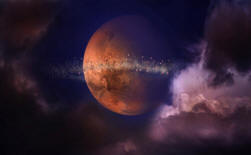|

Medium resolution image of Comet
103P/Hartley 2. Credit: NASA/JPL
Hartley 2 Flyby
Nov 05, 2010
This "hyperactive" comet is
only 1.2 kilometers long but
demonstrates a nucleus more active
than comets twice its size.
As of this publication, the
EPOXI Mission spacecraft
has completed its close flyby (about
690 kilometers away) of comet
Hartley 2. The mission was not as
informative as it might have been,
since optical cameras and an
infrared imager were the only
instruments onboard the retargeted
Tempel 1 mothership.
However, as the spectacular image at
the top of the page attests, visual
results again provided confirmation
that comets are electrical in
nature.
Consensus science sees comets as
"leftovers" from the birth of our
Solar System. It is said that after
the nebular cloud from whence all
was born finished condensing into
our primary, and subsequently, all
the planets, a mass of dust and gas
formed a hypothetical spherical
shell about 30 trillion kilometers
from the Sun. The shell of frozen
material, thought to be close to
absolute zero,
is known as the Oort cloud, after
Dutch astronomer Jan H. Oort.
It is ironic that Oort inferred
the existence of the cloud that
bears his name because he only
studied 19 long period comets. Since
long period comets seem to arrive
from deep space and exhibit
extremely elongated elliptical
orbits, he could not imagine any
other solution than a cold
repository of objects beyond
astronomical observation. Note that
short period comets are known to
revolve in orbits that do not exceed
the distance to Jupiter.
More than six trillion
cometary bodies are supposed to
inhabit the Oort cloud. They are
barely held in place by the Sun's
gravity, so if stars or giant masses
of dust and gas pass too close,
tidal forces can change their orbits
and they will plunge into the inner
Solar System. Conversely, they might
be drawn out into interstellar
space.
However, what has the latest
face-to-face with a comet brought to
the table? Has there been
confirmation of the "dirty snowball"
theory? Or, as EPOXI mission
principal investigator Michael
A'Hearn summarized, is this another
in a series of surprising
experiences?
As previous Picture of the Day
articles have shown, not one image
of a comet has revealed frozen
plains, ice cliffs, slush, or snowy
crystals. Instead, Wild 2, Tempel 1,
Borrelly, Halley, and now Hartley 2
look like asteroids, with hard, dry,
rocky exteriors. Like Borrelly,
Hartley 2 is an elongated potato
tumbling through space. If asked,
this writer would say that it
resembles
asteroid 433 Eros.
What of the jets blasting into
space from isolated regions on the
comet's surface? One unidentified
participant in the live streaming
video of EPOXI's close approach
remarked, "This is almost like
Enceladus." There is no way to know
what level of insight he possesses
regarding electrical activity in
space, but his comments were
perspicacious.
The jets of vapor escaping
Enceladus at supersonic speed and
the bright jets seen on Hartley 2
(as well as other comets) pose the
same problems for space scientists:
despite their contention that narrow
vents or fissures are allowing vapor
to escape into space, no such vents
have been found. There are so-called
"tiger
stripes" on Enceladus, but
rather than being geyser-like
fumaroles, they are actually created
as electric arcs move across the
surface. The jets on comets are most
likely behaving in the same fashion.
When the Stardust mission made
its close approach to comet Wild 2,
similar jets were found. The jets of
vapor did not disperse as one would
expect gas to do in space. As was
reported in a Picture of the Day at
the time, "Chunks of the comet, some
as big as bullets, blasted the
spacecraft as it crossed three jets.
Wild 2's surface was covered with
'spires, pits and craters' that
could only be supported by rock, not
by sublimating ice or snow."
In an Electric Universe, electric
comets are most likely rocks moving
rapidly through the Sun's force
fields. They develop plasma sheaths
that can evolve into comas,
sometimes millions of kilometers in
diameter. Electric arcs connect
their surfaces with the Sun's
electric field and generate
extremely high temperatures in
isolated spots. X-rays and extreme
ultraviolet light have been detected
radiating from
comet Hyakutake, for
example.
Comets pass through a
differential electric potential as
they accelerate toward the Sun. The
variable electric field can cause
visible, glow discharges. Rather
than "dirty snowballs" or even
"snowy dirtballs," comets are
electrically active, solid bodies.
As Electric Universe advocate
Wal Thornhill wrote:
"A history of unexpected
discoveries is the hallmark of a
failed hypothesis. The electrical
model of comets was able to predict
or simply explain all of the
discoveries made during the Deep
Impact mission. The 'outbursts' from
the comet are in the form of
‘cathode jets,’ which are bursty in
nature and tend to jump around from
one high point or sharp edge to
another...Comets have not undergone
'an evolutionary process'. They are
the debris resulting from electrical
discharge sculpting of planetary
surfaces. They belong to ‘families’,
which characterize their parent
planet."
Stephen Smith
Multimedia

“When Meteorites Fell from Mars”
|








